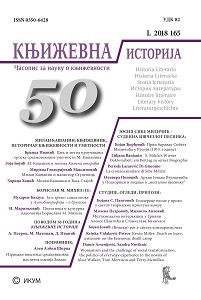Мултимодална интеракцијa у Гривни Алексе Шантића и Станислава Биничког
Multimodal interaction in ’Grivna’ by Aleksa Šantić and Stanislav Binički
Author(s): Milena Petrović, Mihailo AntovićSubject(s): Serbian Literature
Published by: Институт за књижевност и уметност
Keywords: Multimodality;Šantić;Binički;Grivna;figures of speech;zigzag;music transposition;staccato;circle;rondo form;
Summary/Abstract: In cognitive linguistics there is a tendency toward a holistic view of language, which incorporates the language faculty into multimodal experience, since various cognitive modes are thought to strongly influence language acquisition. In addition to the cognition of visual and spatial relations, bodily experience and in particular the resultant concept of “embodiment” have played an important role in introducing the notion of multimodality into the language science. On the other hand, in cognitive musicology, studies of interactions between musical elements and other modalities, for instance image or text, are getting increasingly common. With these questions in mind, the goal of the present article is to uncover and analyze multimodal aspects of the poem “Grivna” (“The Bracelet”) by poet Aleksa Šantić, which later attracted composer Stanislav Binički, who wrote a Lied accompanying this poetic text. The richness of figures of speech used in the poem results in a multimodal poetic image, originating from the synergy of sound (the rattling of the bracelet), image (that of a golden bracelet) and motion (a girl dancing), especially given in the expression “cika-caka” (zig-zag), where the aural, visual, and spatial modalities interact. Multimodal interaction, i.e. simultaneous perceptual experience inspired by the poetic images by Šantić, is particularly pronounced in the musical transposition of the verses: the mapping between the type of the girl’s movement (jumpy and zig-zag motion) and the aural qualities of the words is enhanced by the musical articulation (staccato); the sequencing of beads in the bracelet, followed by the physical zig-zag sound produced by it, is supported by a melody which first ascends and then descends; finally, the girl’s dance and the bracelet’s circular shape are additionally motivated by the circular poetic form and the musical rondo form.
Journal: Књижевна историја
- Issue Year: 50/2018
- Issue No: 165
- Page Range: 205-222
- Page Count: 18
- Language: Serbian

